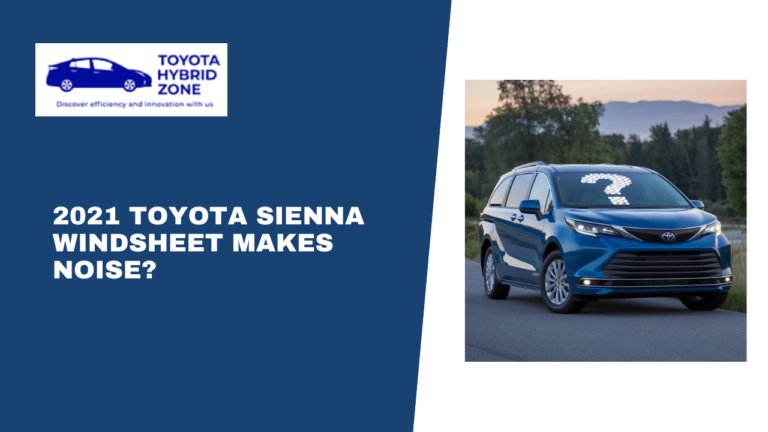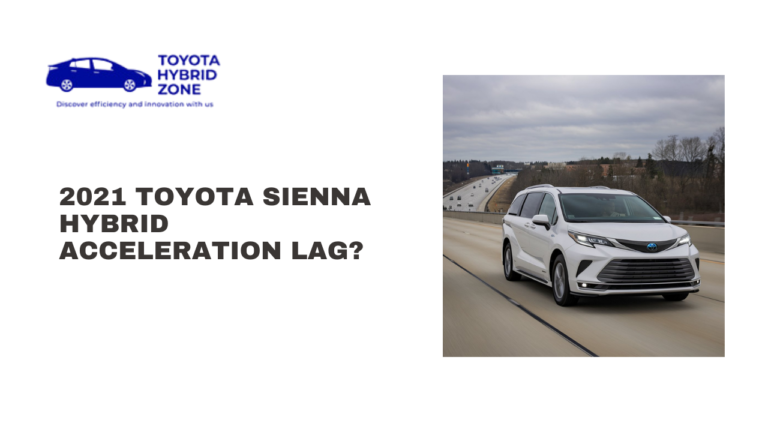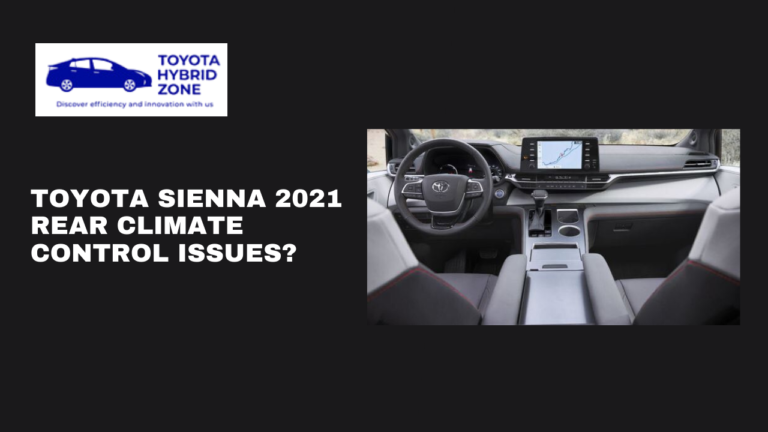2015 Toyota Sienna Hybrid Braking Issues? How to Diagnose and Fix Them Quickly”
Understanding the other issues is essential to ensure your family’s and your own safety. Some common issues range from a soft brake pedal to squeaking and grinding brakes to pulsating brakes.
In this blog post, we shall discuss these issues based on experiences, expert opinions, and some reliable sources. We’ll take a glance at what it could be, potential solutions, and preventive measures to have your 2015 Toyota Sienna Hybrid braking system working in tip-top shape.
Short Answer:
Fuel efficiency, a spacious interior, and a robust structure are some of the perks of the 2015 Toyota Sienna Hybrid; however, there have been reported problems with its braking system, though these issues are not that widespread, there is still a concern on the minds of owners and technicians.
Some Common Problems:
Brake Pedal Pulsation or Vibration:
- Symptom: It pulsates or vibrates while pressed when attempting to hard brake under higher speeds.
- Cause: Usually blamed on twisted brake rotors, caused by overheating or rapid temperature fluctuation.
- Solution: Replace or resurface the twisted brake rotors.
Soft or Spongy Brake Pedal:
- Symptom: Low pedal pressure or will not push down with no brake force
- Cause: This could be due to several things including worn-out brake pads, air in the brake lines, or a problem with the brake booster.
- Solution: Inspect and replace worn parts, bleed the braking system of air, or change or repair the brake booster.
Delayed Brake Feeling:
- Symptom: The vehicle takes a noticeably longer time to begin responding to brake pedal input and thus travels farther during stops.
- Cause: Possible causes include low levels of brake fluid, faulty brake sensors, or an electrical malfunction in the electronic brake control systems.
- Solution: Checking and topping up brake fluid, checking and replacing faulty sensors, or diagnosing and repairing electronic brake-control faults.
“To estimate your potential fuel savings, use our Fuel Savings Calculator . Simply input your current fuel consumption and desired improvement to see the estimated savings.”
What Are The Common Braking Issues An A 2015 Toyota Sienna Hybrid?

Even though the 2015 Toyota Sienna Hybrid is a very reliable car, it’s not completely immune to some potential braking problems. Here are some common problems reported by owners:
1. Brake Rotor Warping:
- Prevalence: This condition occurs relatively frequently, especially in owners who engage in frequent heavy braking, such as towing or mountain driving.
- Symptom: Pulsating or vibrating brake pedal, especially when braking at higher speeds.
- Cause: Braking excessively due to excessive heat buildup during heavy braking makes the brake rotors warp, leading to uneven braking and reduced stopping power.
- Remedy: Replace warped brake rotors.
2. Brake Pad Wear:
- Occurrence: A normal wear and tear condition which arises over time
- Symptom: Squealing or grinding noises at braking times
- Cause: Brake pads wear down might produce these noises and also lose their effectiveness.
- Remedy: Replace worn-out brake pads.
3. Brake Fluid Problems:
- Incidence: Rare, but can happen when brake fluid leaks or the fluid itself is contaminated.
- Symptoms: Soft brake pedal, increased stopping distance, or brake warning lights.
- Causes: Not enough brake fluid, air in brake lines, or dirty brake fluid can compromise braking.
- Solution: Check and replace brake fluid, remove air from the brake system, or replace contaminated fluid.
4. Hybrid System Problems:
- Rare but can happen in certain conditions.
- Typical symptom: Slightly delayed or inconsistent brake response, especially during transitioning between regenerative braking and friction braking.
- Cause: Problems with the electronic control units or sensors of the hybrid system may hinder proper braking.
- Solution: Diagnosing and rectifying any problems present in the hybrid system’s electronics.
“While both FWD and AWD Sienna models offer reliable performance in various weather conditions, AWD models can provide additional traction and stability in snowy or icy conditions. For a deeper dive into the winter performance of these two configurations, refer to our dedicated article: [Toyota Sienna AWD Vs FWD Winter Performance?]”
Why Is The Brake Pedal Soft In A 2015 Toyota Sienna Hybrid?

A soft brake pedal in a 2015 Toyota Sienna Hybrid can be of concern since it impacts the braking performance as well as safety. There are many reasons for this problem:
1. Low Brake Fluid:
Frequency: This is usually common as it may be due to leakage or fluid evaporation.
Cause: A low brake fluid level causes a soft, spongey brake pedal.
Solution: Checking and replenishing the brake fluid to the recommended level.
2. Air in the Brake Lines:
How Often: This happens after brake work or a fluid change.
Cause of Problem: Air in the brake lines can compress when compressed, causing the brake pedal to go soft.
Solution: The brakes need to be bled to remove air from the system. This is accomplished by pumping the brake pedal while opening the bleeder valves to allow air to escape.
3. Brake Pads Worn:
Frequency: It’s a typical wear and tear problem, hence occurring after a certain period.
Cause: A worn-out brake pad might not give adequate braking force and cause a soft pedal.
Solution: Replacing the worn-out brake pads
4. Faulty Brake Booster
Frequency: It is less frequent but may occur either due to aging or due to malfunctioning.
Cause: A brake booster, an accessory that assists in building pressure while applying brakes, can cause a soft pedal if it starts malfunctioning.
Solution: Checking for repair/replacement of the brake booster.
5. Hybrid System Problems:
Frequency: Rare, but maybe there sometimes.
Cause: A fault of the Electronic Control Units or sensors in the hybrid system which makes the brakes less responsive and one might find it having a soft pedal.
Solution: Diagnose and repair the defective parts.
“If you’re experiencing wind noise issues with your Sienna, check out our article on troubleshooting common wind noise problems: [Toyota Sienna Windsheet Makes Noise?]”
What Causes Brake Squeaking And Grinding In A 2015 Toyota Sienna Hybrid?
Brake squeaking or grinding sounds that occur in a 2015 Toyota Sienna Hybrid often point to an underlying problem in the braking system. Listed here are the main causes:
1. Worn Brake Pads:
Incidence: This is the most common cause, occurring approximately every 25,000 to 35,000 miles or 2-3 years under normal driving conditions.
Symptom: High-pitched squealing noise when braking.
Cause: As the brake pads wear out, their friction material wears thin, causing the metal to meet metal, resulting in the noise often heard.
Solution: Replace worn brake pads.
2. Rusty Or Glazed Brake Rotors:
Likelihood: Often a result of infrequent use, exposure to moisture, or excessive heat.
Noise Complaint: Louder squeaking or grinding noise when stopping slowly.
Cause: Rust on the rotors, or glazing on the rotor surfaces thins the friction and produces noise.
Solution: Resurfacing or replacement of brake rotors.
3. Buildup Of Brake Dust And Debris:
Applicability: Over a while, especially in cities.
Symptom: High-pitched screeching noise.
Cause: Dust and debris get collected on the brake pads and rotors due to which friction is reduced and noise is produced.
Solution: Cleaning brake components with a brake cleaner.
4. Poor Brake Pads Quality:
Applicability: Relatively less often, either from other car brake pads manufacturers or from low-quality brake pads.
Symptom: Squealing or grinding metallic noise.
Cause: Brake pads of poor quality might not possess the necessary friction material and wear indicators, thereby causing noise and a poor braking condition.
Solution: Change the low-quality brake pads with a well-known brand.
5. Warped Brake Rotors:
Frequency: This can also be caused because of too much heat or shock caused due to a sudden temperature change.
Symptom: Pulsating or vibrating brake pedal along with the grinding noise.
Cause: They cause uneven braking and also noise.
Solution: Change the warped brake rotors.
Ensure peak performance of your Sienna’s hybrid system. Use our Hybrid Battery Health Checker Tool to assess your battery’s health and take necessary actions.
What Are The Signs Of A failing Regenerative Braking System In The 2015 Toyota Sienna Hybrid?
A failed regenerative braking system on a 2015 Toyota Sienna Hybrid can negatively affect the fuel efficiency of the vehicle. Here are some of its key symptoms to look out for:
1. Loss Of Regenerative Braking
Symptom: A lessened engine braking when taking your foot off the accelerator pedal.
Cause: The regenerative braking system fails to transform kinetic energy into electrical energy as effectively.
Resolution: Get in touch with a Toyota technician for an extensive evaluation and repair.
2. Greater Brake Pad Degradation
Symptom: Replacing brake pads too often.
Causes: Poor operation of regenerative braking technology may cause friction brakes to do more work in terms of slowing down the car, thereby subjecting them to increased wear.
Solution: Keep your brake pads regularly checked and replace them when necessary.
3. Noises Or Vibration
Symptom: Squeaking, grinding, or pulsating noise from the brake system.
Cause: A faulty regenerative braking will cause excessive stresses on the classic brake parts and, therefore, unwanted wearing and noise.
Solution: Have your brake system checked and inspected by a professional mechanic.
4. Depleted Gas Mileage:
Symptom: Gas mileage has drastically decreased.
Cause: Regenerative braking helps to restore the hybrid battery while gaining the best possible mileage. But if it’s not working right, mileage will be diminished.
Solution: Fix the problems related to the regeneration braking system so that it functions well and returns to the proper fuel efficiency.
5. Dashboard Warning Lights:
Symptom: Brightness of the brake warning light or hybrid system warning light.
Cause: The warning lights are often associated with a problem in the regenerative braking system or their related components.
Solution: Consult a Toyota technician for diagnosis and solution.
“While the Sienna Hybrid is known for its fuel efficiency and smooth performance, some owners may experience occasional acceleration lag. For more information on troubleshooting this issue, refer to our dedicated article: [Toyota Sienna Hybrid Acceleration Lag?]”
My Personal Experience:
I also faced a soft brake pedal condition with my 2015 Toyota Sienna Hybrid, which was caused by air in the brake lines. Fixing that involved thorough brake system bleed at the cost of around $150 from a local repair shop.”.
Also, there would be persistent squeaks and sometimes grinding when braking. On inspection, I discovered that the brake pads had worn down to under 2mm when 3-4mm was the recommended minimum. Replacement and resurfacing of the rotors solved this problem at a cost of about $300 for the parts and labor.
The other critical lesson I learned is to get braking issues addressed sooner rather than later, lest it lead to further problems, such as damage to the regenerative braking system, which is significantly more expensive to repair-often more than $1,000. Since then, regular maintenance such as checking brake fluid levels and inspecting brake pads every 10,000 miles has helped prevent additional problems.
If you have similar problems, I suggest going through a diagnostic scan to identify the problem. Proactive care in the majority of instances will save you money and let your ride stay safe to drive.
What Are The Dangers Of Ignoring Braking Issues In A Hybrid Vehicle?
Ignoring problems with braking in a hybrid vehicle can be highly dangerous and lead to accidents and even loss of life, both yours and others. Here are the key hazards:
1. Lower Braking Force:
- Greater Stopping Distances: Faulty brakes can increase stopping distances, especially during emergency stops. This increased stopping distance can cause accidents.
- Loss of Control: In critical situations, such as emergency braking, a weakened brake system may not function effectively, and one may lose control of the vehicle, resulting in potential collisions.
2. Accelerated Wear and Tear:
- Premature Brake Pad and Rotor Replacement- Failure to address minor issues leads to accelerated wear and tear of brake components, requiring more frequent and costly replacements.
- Damage to Other Components: Complete brake failure can damage other components in the braking system, like calipers and brake lines, making the repair even more expensive.
3. Loss Of Regenerative Braking Effect:
- Loss of Fuel Economy: A damaged braking system will deter the regeneration of kinetic energy. Regenerative braking is an important attribute of a hybrid vehicle, which ensures the recapture of kinetic energy to improve fuel economies.
- Increased usage of conventional brakes: A malfunctioning regenerative braking system causes increased reliance on conventional friction brakes, which in turn increases wear and tear rates, resulting in lower efficiency overall.
4. Safety Risks:
- Enhanced Collision Chances: A malfunctioning braking system has a heightened chance of accidents such as rear-end collides or side-swipes, not to mention worse accidents.
- Risk of Vehicle Fire: In extreme cases, brake failure results in overheating with a possible risk of vehicle fires.
To reduce the risks, any braking problem should be addressed promptly. If you experience any of the following symptoms, contact a qualified technician ASAP.
- Unusual noises; squeaking, grinding, or pulsating sounds.
- The brake pedal feels spongy or hard.
- Vibrations in the brake pedal or steering wheel.
- Reduced braking performance.
- Warning lights in the dashboard.
How Can I fix Braking Problems In My 2015 Toyota Sienna Hybrid?
Understanding The Problem:
Start by diagnosing problems with your 2015 Toyota Sienna Hybrid. Some common problems include:
- Worn Brake Pads: The most common problem and typically needs replacement every 25,000 to 35,000 miles.
- Warped Brake Rotors: Exposure to excessive heat distorts rotors, resulting in pulsation and vibration.
- Low Brake Fluid: Low levels of fluid can cause a soft brake pedal and decreased braking power.
- Faulty Brake Calipers: Braking pads wear out unevenly, and braking performance is low.
- Hybrid System Problems: It may sometimes interfere with the ordinary braking performance and cause a slow response or other problems.
Simple Homemade Solutions For Minor Problems:
- Check and Replace Brake Pads: If you are comfortable and skilled in the art of working with basic automotive maintenance, you can examine your brake pads. Should it read less than 3mm of pad material, consider replacing them.
- Check and Refill Brake Fluid: Ensure that the brake fluid is between MIN and MAX on the reservoir. If it is low, top it off with the correct brake fluid.
Professional Assistance:
For more complex issues, or if you are unsure about DIY repairs, consult a qualified mechanic. They can:
- Diagnose the Problem: Using specialized tools, pinpoint the exact reason the brakes are malfunctioning.
- Replace Worn Components: Replace worn brake pads, rotors, or calipers as needed.
- Bleed the Brakes: If air has entered the brake lines, bleeding the brakes can restore proper pedal feel.
- Check the Hybrid System: Look for any problems with the hybrid system that could be causing a braking problem.
Preventive Maintenance:
To prevent future braking issues, here’s what to do:
- Schedule Brake Inspection Every 6 months or 6,000 Miles
- High-Grade Components: Be sure to make use of high-grade components to avoid their early wear and tear.
- Avoid Aggressive Braking: Aggressive braking causes the running components to undergo premature wear and tear.
- Professional Maintenance: Let the qualified technician perform services on your vehicle.
The Sienna offers spacious seating, advanced technology, and impressive fuel efficiency. To explore other Toyota Hybrid options and compare them side-by-side, check out our Toyota Hybrid Model Comparison Tool.
How Much Does Repairing Or Replacing The Braking System Cost In The 2015 Toyota Sienna Hybrid?
The cost of a braking system repair or replacement in a 2015 Toyota Sienna Hybrid can vary depending on specific trouble, the severity of it, the parts used, and your area’s labor cost. However, that being said, a general breakdown is represented below:
Minor Repairs:
Brake Pad Replacement: This is the most commonly performed repair and will run anywhere between $150 and $300 per axle, including parts and labor.
Brake Rotor Resurfacing: When the rotors are warped but not excessively damaged, resurfacing them will be charged around $50 to $100 per rotor.
Major Repairs:
Brake Rotor Replacement: Replacing a warped rotor will cost between $150 and $300 per rotor, including parts and labor.
Brake Caliper Replacement: Replacing a bad brake caliper will cost between $200 and $500 per caliper, including parts and labor.
Brake Fluid Flush. Brake fluid flush, where the old brake fluid is replaced with a new one, will cost between $100-$200.
Conclusion:
The 2015 Toyota Sienna Hybrid is a good vehicle, but nothing is truly brake lock-proof. Some common issues that may occur include brake rotor warping, brake pad wear, problems with brake fluid, and hybrid-related issues. For your safety and the reliability of your vehicle, it is a wise idea to consider some braking issues right away. Good maintenance habits, professional diagnosis, and safe driving habits can all work to help prevent and mitigate such problems. If you do experience any unusual braking behavior, consult a qualified technician for a comprehensive diagnosis and proper repairs.
How often should I replace my brake pads and rotors?
Typically, brake pads need replacement every 25,000 to 35,000 miles. Brake rotors may need resurfacing or replacement every 50,000 to 70,000 miles, depending on driving conditions and maintenance.
What are the signs of a bad brake caliper?
Signs of a bad brake caliper include uneven brake pad wear, pulling to one side during braking, and a burning smell.
How can I improve my hybrid vehicle’s braking performance?
Gentle braking: Avoid hard braking, as it can lead to excessive heat buildup and brake wear.
Regular maintenance: Adhere to the recommended maintenance schedule, including brake inspections and fluid changes.
Professional diagnosis: Consult a qualified technician for any unusual braking behavior.
Can I fix a soft brake pedal myself?
In some cases, a soft brake pedal can be fixed by bleeding the brakes to remove air from the brake lines. However, for more complex issues, it’s best to consult a professional mechanic.
How often should I have my brake fluid flushed?
It’s recommended to have your brake fluid flushed every 2-3 years or 30,000 miles to maintain optimal braking performance.






